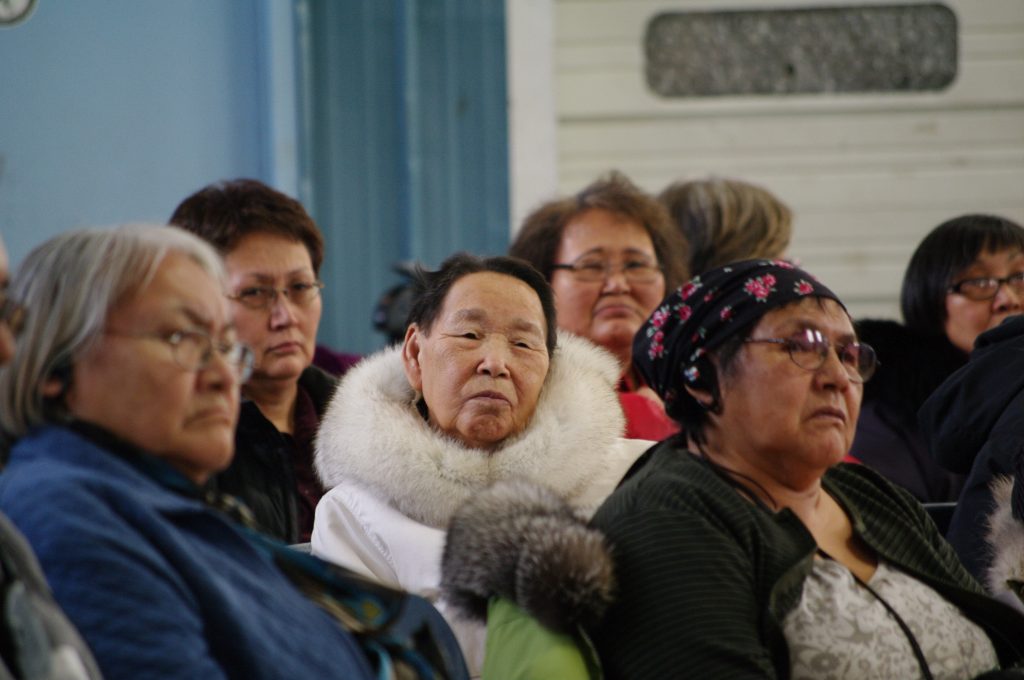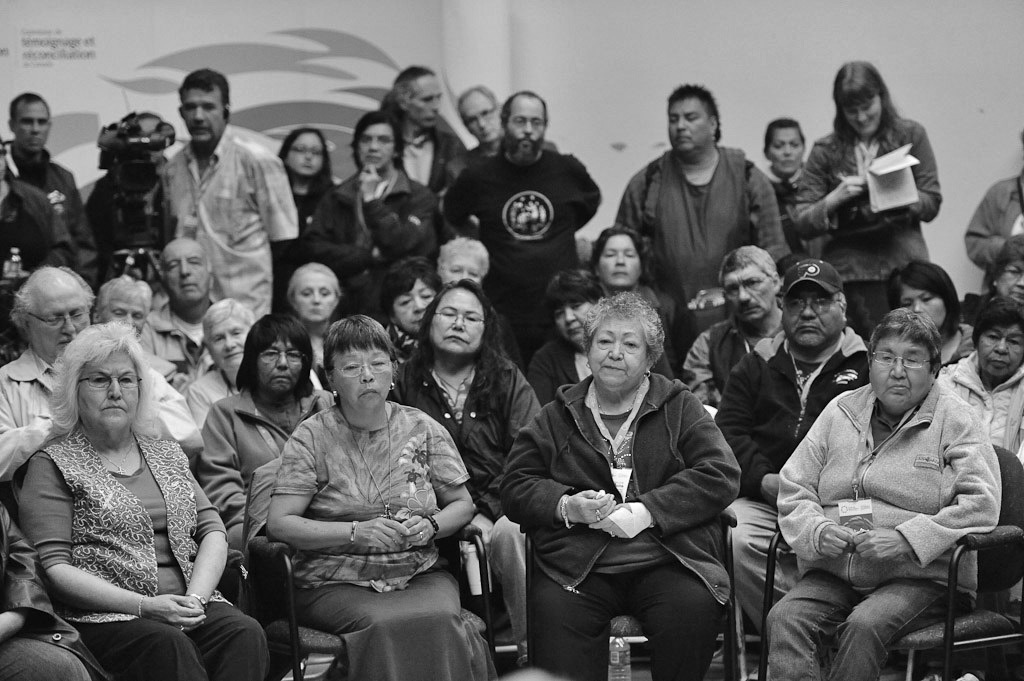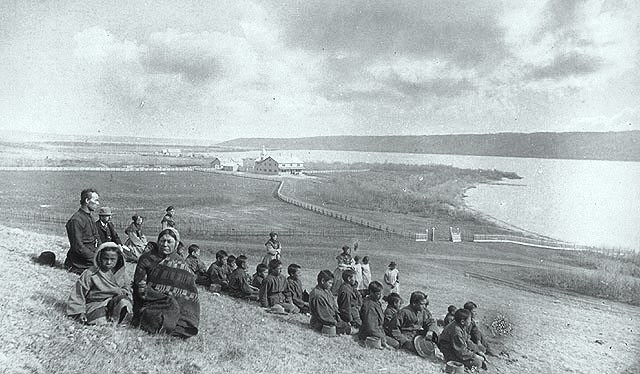A Weak Commission Brought Forth Survivors’ Truths, but Has It Made Reconciliation Possible?

Leona Bird remembers being taken away from her mother to be sent to the Prince Albert Indian Residential School in Saskatchewan at the age of 6. “Kids were herded into there like cattle, into the army truck,” she told the Truth and Reconciliation Commission of Canada during a public hearing. “I was so scared. I didn’t know what was going on.”
Approximately 150,000 Indigenous students were housed—or incarcerated, since students were often prevented from returning home during holidays or receiving visits from family members—in 139 federally funded, but church-run, Indian residential schools in Canada. The schools were in existence for over a century—with the last school finally closing in 1996. Some 80,000 of these students are alive today.
When the commission completed its work and submitted its six-volume final report in 2015, which included 94 recommendations or “calls to action,” it had gathered statements over a period of five years from more than 6,750 people. These statements provide a harrowing picture of the schools, including stories of emotional, physical, and sexual abuse.
Many of these statements—including Bird’s and those of others quoted here—were presented in The Survivors Speak, a supplement to the commission’s report. Their truths are ones that needed to be told, but they do not capture a complete picture of the misguided values and ideas that led to the establishment of the schools and the way they operated. Most of the priests, brothers, and nuns who had administered or worked in the schools stayed away from the events of the commission, and there was no way to compel them to attend.
The Truth and Reconciliation Commission of Canada was established in 2008 as one outcome of the 2007 Indian Residential Schools Settlement Agreement, which resulted from thousands of individual and class-action lawsuits against the government and churches by former students. This agreement was far-reaching and multidimensional. It included an apology from the Canadian government (delivered in parliament by Prime Minister Stephen Harper in 2008), several years of funding for the Aboriginal Healing Foundation (which dealt largely with the mental health impacts of residential schools), and a compensation package that was to exceed $3 billion in Canadian dollars (equivalent to US$2.3 billion today), the largest judicial settlement in Canadian history.
Compensation was divided between a “common experience payment” for all those who could document their attendance at a recognized Indian residential school and an “independent assessment process,” which established a system of out-of-court hearings and compensation for those who experienced harm in the schools. The settlement agreement also brought into being the Truth and Reconciliation Commission and a National Centre for Truth and Reconciliation where the information the commission gathered would be kept.
The commission had a restricted mandate: It could not hold formal hearings or act as a public inquiry, and it had no subpoena powers to compel unwilling witnesses to give testimony. This left it with solely voluntary participants: those who wanted to tell their stories. They were not referred to as “witnesses” in the judicial sense, were not cross-examined or subjected to any factual substantiation, and were not allowed to reveal the identity of anyone they remembered as being an unpunished perpetrator of a crime.
Explore this photo essay from the archives: “Native American Children’s Historic Forced Assimilation.”
This non-judicial mandate also meant that those federal officials who established or implemented the residential school policy were under no obligation to offer statements. The federal government kept the events of the commission at arm’s length, with ministers or deputy ministers giving mostly non-committal statements supporting the activities of the commission. The churches sent high-level representatives to acknowledge responsibility, deliver eloquent apologies, and offer “gestures of reconciliation” such as DVDs providing information about church-sponsored healing initiatives.
The result was one of the more survivor-centric truth commissions in recent years. This focus, which is becoming a trend in representations of traumatic history, makes it more difficult to fully understand the views and experiences of those who designed and operated the schools. With no power to compel evidence, the commission was left with scant information about the perpetrators and their motives, as well as the institutions that harbored them. Such perspectives remain largely confined to what can be gleaned from documents, unembellished by the emotion and immediacy of public testimony. Thus those who would defend destructive institutions, such as the priests, brothers, and nuns I spoke to outside the venues of the commission, were never forced to confront the contrary opinions and experiences of those who were harmed by them.
In the commissioners’ sharing circles, usually held in conference centers with as many as 1,000 people in attendance, participants spoke into a microphone with quavering voices, often pausing for breath—receiving comfort from a friend or family member—sometimes hiding their trembling hands under the table. The emotions of those who made statements were contagious. Mental health providers were available to offer comfort to those most openly expressing sympathetic grief.
The speakers told stories of separation, confusion, and abuse. Sheila Gunderson, who attended several residential schools in the Northwest Territories between 1958 and 1971, said, “I didn’t know I had an older sister until I was I think probably 13 years old and somebody came and introduced us and said that we were sisters.” Fred Brass said of the Roman Catholic school in Kamsack, Saskatchewan: “I saw my brother with his face held to a hot steaming pipe and then getting burned on the arm by the supervisor. … I got beat so bad that I wet my pants.”
The commission’s public events created spaces of affirmation that were free from stigma. The commission would screen “highlight reels” of the most poignant statements of abuse, loss, and loneliness, and invite survivors who were experienced in giving testimony to be the first to present public statements. This encouraged other former students to push past whatever inhibitions they might have had about publicly disclosing traumatic experiences and made it possible for survivors of abuse to speak.
But this emphasis also provided templates of familiar themes and styles of narration. The commission became much more than a listener or receptacle of knowledge; it also shaped that knowledge. It brought the categories of survivor and perpetrator sharply into focus and made the status of “residential school survivor” a positive source of identity. As important as it was to give voice to those whose experiences of abuse were long kept secret or ignored, this affirmation of survivor experience comes with a cost.
As an anthropologist with many years of experience living and working in several Cree communities in northern Quebec and Manitoba, I put together a team of research assistants and spent the five years during which the commission conducted its work knocking on doors. I wanted to hear the stories of those who did not step forward for the public hearings in order to get a better sense of what the commission was including—and what it was not. Overall, I spoke with more than 30 nuns, priests, and former students, and I attended each of the commission’s seven national events.
Almost all the nuns and priests recalled the schools as places of love and learning. As I sat through these interviews, I could not help recalling what I had heard about the schools from statements gathered by the commission, and I was struck by the interviewees’ obliviousness to or denial of survivors’ experiences. They fondly remembered skating on frozen lakes and playing hockey with the children, as well as teaching skills like baking and sewing. Only one priest remembered having to fire someone for reasons of abuse. They uniformly rejected the accusations leveled at them. “I never heard of the, [what] they call, the physical abuse and sexual abuse. I never heard of that,” said one priest. “I heard that years after I left there, when they started to sue me.” This priest was accused through the “independent assessment process”; he was neither brought under criminal charges nor exonerated.
One priest, proudly recalling the military drills given to students in the Fort Qu’Appelle Indian Residential School in Saskatchewan, exclaimed, “We gave them personalities!” What was clearly outside the cultural values of those being educated was, to him, simply character forming. “They keep their culture with language,” said another priest. “[We] give them the tools to survive in this new society where they’re dominated by Europeans or whites. … You need new skills. Integration.”
From yet others there was silence, including from many of the former students I spoke with who said they had nothing to say. Even though they were in solidarity with family members and people from their community who had experienced harm in the schools—with long-lasting consequences that extended from generation to generation—they felt that having no stories of abuse or serious difficulties meant they had nothing to contribute.
The commission’s report contains some statements from these people but they are vastly drowned out by the more plentiful and emotional testimonies of survivors of abuse.
There is good reason for this. Unlike, say, the aftermath of a civil war or of apartheid in South Africa, where the abuses of the state were widely known and experienced, Canada’s commission assumed that most non-Aboriginal Canadians did not know anything about residential schools. Thus it took on the task of public education and of reforming the dominant historical narrative of the country. As one former student remarked to me, “The churches have had the dominant discourse for more than 100 years. Now it’s our turn.”
I am sympathetic to this view. But there’s something about it that is discomforting. I am unconvinced that reconciliation can be arrived at by cultivating a certain narrative in a context intended primarily to affirm survivor experience.
Other truth and reconciliation commissions have had stronger mandates. After the forced displacements, killings, detention and torture, and other massive human rights violations under Indonesian rule in East Timor, or Timor-Leste, from 1974 to 1999, a commission was empowered to make findings in relation to international and domestic law about the individuals responsible for crimes; as a result, people were prosecuted up to the highest levels of government. In South Africa, there was a complex provision of amnesty for people who came forward with confessions; the country’s commission had the power to compel testimony and to initiate prosecution when the accused did not cooperate with honesty and sincerity.
The weak mandate of the Canadian commission, particularly its absence of subpoena powers, seems to have suited both sides. The government was spared a wider, more dramatic public exposure of the crimes of the state, and survivors were protected from possible encounters with unrepentant perpetrators, along with their denials, justifications, and distorted visions of history. But reconciliation requires all those involved in harm on a vast scale to engage in the struggles of remembering.
At this point, there would be little public or political appetite for reopening Canada’s residential schools to more judicial scrutiny. But there are lessons to be learned from this experience moving forward. A truth commission that works is one that both protects survivors and uses the tools of the law to expose perpetrators’ actions and undo their power.
The Canadian government launched an independent national inquiry into missing and murdered Indigenous women and girls this August. This time, at least, the inquiry has a mandate under Canada’s Inquiries Act to compel testimony and even to set in motion criminal prosecutions. The testimonies that emerge under these circumstances will play a significant role in the degree to which the Aboriginal communities involved find justice and reconciliation.

































